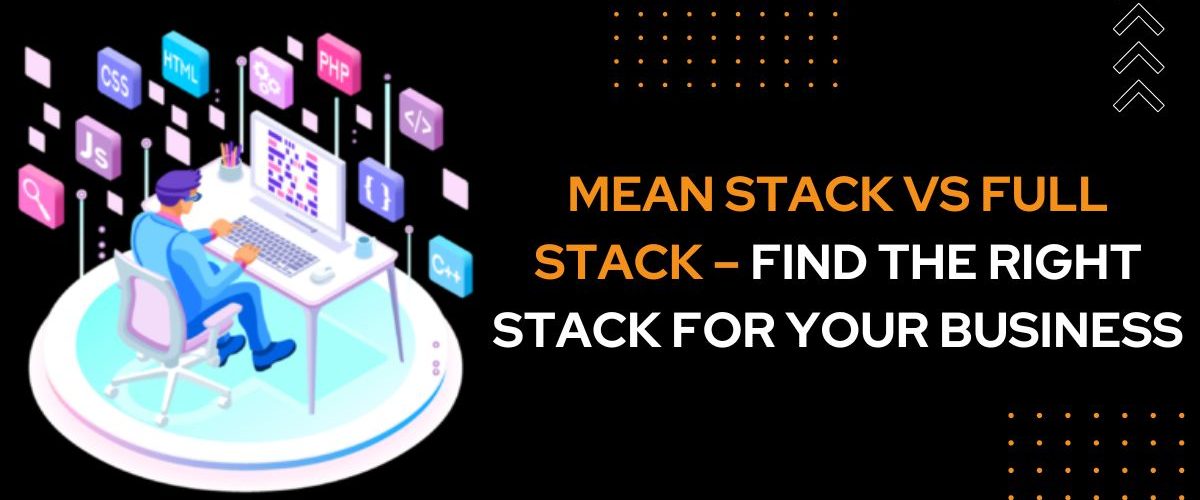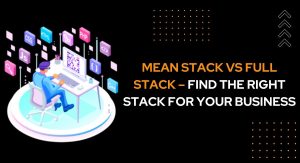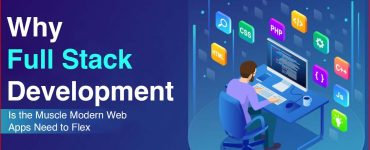
Mean Stack Vs Full Stack – Find the right stack for your business
Stack! A difficult word for some of us, right? To use these stacks to develop your next system, you must be a tech enthusiast or a successful businessperson with an innovative idea. Learn more about selecting the best stack technology by comparing Mean Stack vs Full Stack. You have selected the right page, read on to explore more!
What is Full-Stack Development?

A jack-of-all-trades, or full-stack developer, is knowledgeable in both front-end and back-end development. She or he holds a top position inside the organization and has the authority to direct and advise on the creation and administration of projects.
They are proficient in a variety of front-end development frameworks and have extensive knowledge of all phases of web development, including database management, meeting mission-critical needs, designing user interfaces, and more.
There are several different streams from which skilled developers might choose, including Frontend, Backend, Database, Mobile App, and Testing. The developers have previously developed specialized knowledge in one of the aforementioned domains and continue to work in that sector. The current patterns, though, have shifted. The demand for technologies has compelled developers to work on both the front end and the back end as well as many other things.
Full Stack Developers are in the spotlight due to the many advantages they provide, including multi-technology projects that result in excellent UX/UI and most likely unique code for several technologies.
Today’s developers are capable of understanding and resolving issues in a variety of software development streams. Companies are working hard to find full-stack developers who can create a website or application from the ground up without stopping.
What is Mean Stack Development?
The full-stack development community includes the typical stack developer. A full-stack developer creates online apps using a full-stack collection of JavaScript technologies. Everything is written in JavaScript, including the server, clients, and databases.
An application that is faster and more reliable is produced with MEAN. The MEAN stack is a more efficient, open-source, and user-friendly toolkit for creating dynamic web pages and applications.
A collection of JavaScript-based technologies known as the “MEAN Stack” are used to create sophisticated websites and web applications (progressive or responsive). MEAN is essentially described as a full-stack JavaScript framework that streamlines and expedites web and application development.
A combination of MEAN Stack technologies, including MongoDB, Express.JS, Angular, and Node.JS, is used in mobile and web applications. Recently, MEAN Stack has been used to power some complex websites and responsive web apps.
One of the most rapidly expanding open source stack development frameworks is MEAN Stack, which helps developers or teams with well-liked tools or plugins to cut down on system administration time and speed up the deployment of web apps, websites, and APIs so they can focus on the intricate development process of their project.
- Your back-end application uses MongoDB, a document database, to store its data as JSON (JavaScript Object Notation) objects.
- A Node.js-based back-end web application framework called Express (also known as Express.js)
- Angular is a front-end web app framework that allows you to run JavaScript code in the user’s browser to create dynamic user interfaces for your applications.
- Node.JS: JavaScript runtime environment, which enables you to implement the JavaScript back end of your application.
Mean Stack vs Full Stack
Here are some points that show you the exact difference between Mean Stack Vs Full Stack.
1. Programming languages and frameworks
Full Stack
A full-stack developer is familiar with all the programming languages and web development frameworks needed to create a fully functional website.
Mean Stack
A MEAN stack developer is familiar with the four development tools and frameworks because it is a crucial component of full stack development.
2. Name and Usage
Full Stack
Usually, when you say “full stack,” you mean the developer.
Mean Stack
The term “MEAN stack” usually refers to the full stack framework represented as its acronym.
3. Skills
Full stack developer
An all-arounder joins your team when you hire a full-stack developer. The following skill sets are ideal for a full-stack developer:
- Possess in-depth knowledge and comprehension of HTML and CSS.
- Understand JavaScript in its entirety.
- Possess practical expertise with backend programming languages such as Python, PHP, RUBY/RAILS, SQL, Java, and others.
- A working understanding of databases and online storage.
- Understand the principles of web architecture, including file separation and storage, data structure, code structuring, and others.
- Having a GitHub profile and practical expertise with Git.
Mean Stack Developer
These are some of the skill sets you should look for when hiring a MEAN stack developer for your company. Typically, a MEAN stack developer should:
- Focus on both the frontend and backend procedures.
- Possess a solid understanding of programming templates and architecture design standards.
- Recognize the database architecture.
- Be able to work both with CSS and HTML comfortably.
- Possess expertise in additional facets of web development, such as continuous integration, cloud technologies, and architectures.
- Possess knowledge of software development cycles and be able to create apps and websites using the agile development framework.
- Possess in-depth knowledge of MEAN frameworks and technologies.
So, that’s all about Mean stack vs Full Stack. You observed several MEAN Stack Development and Full Stack Development capabilities and applications in this blog. According to the needs of your company, you can select either one of the two options. I would advise that instead of choosing between these two, you should take into account the aspects of both that meet your requirements; in other words, you should first describe your project’s requirements before mapping them to determine which option is better for your project.





